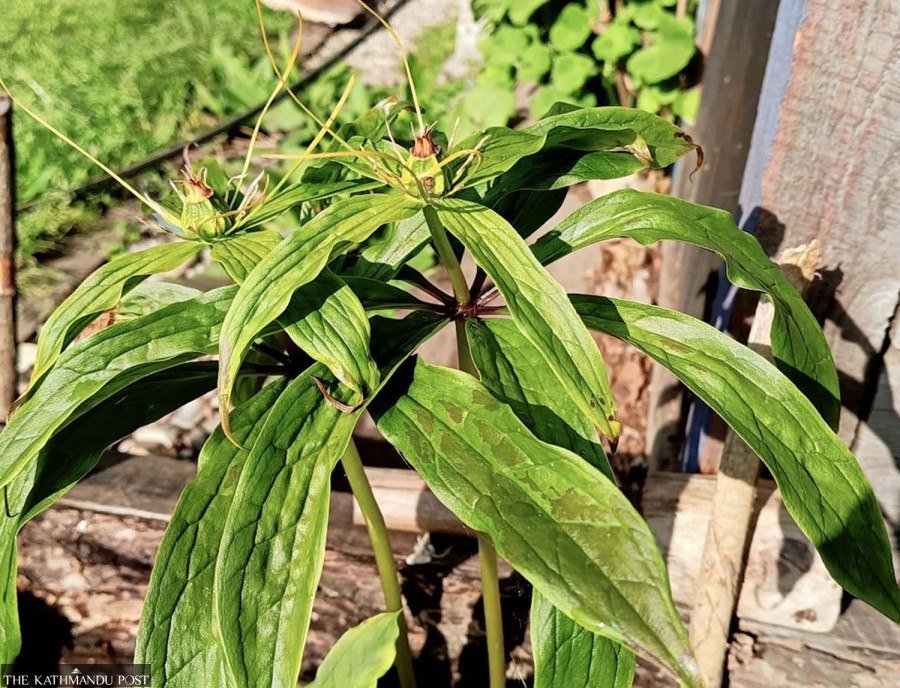National
Invasive plants spread in Myagdi forests as grazing practices decline
Traditional grazing kept invasive plants in check, but its decline has hit herbs collection, local incomes, and government revenue.
Ghanshyam Khadka
A sharp decline in traditional grazing practices is fuelling the rapid spread of invasive plants in Myagdi’s forests, causing a dramatic drop in the production of valuable medicinal herbs. This had led to falling herb yields, shrinking incomes, and reduced government revenue.
According to the Division Forest Office in Myagdi, data from the past five years show a continuous decline in the collection and export of precious medicinal herbs like yarsagumba, satuwa, nirmasi, and vishjara. The primary cause, experts say, is the abandonment of traditional grazing practices that once helped maintain forest biodiversity and controlled invasive plant species.
“Since people have stopped taking livestock to the highland pastures, weeds that animals used to graze on have spread unchecked. The once-abundant allo plant is now difficult to find in the pastures where buffaloes and cows used to graze,” said Bhakta Purja, a member of the Ramche Community Forest Users Committee.
The shift away from traditional animal husbandry—mainly due to youth migration for foreign employment—has reduced open grazing and mobile livestock sheds, locally known as ghumti goth. This shift, according to the forest officials, is damaging both the local economy and forest ecosystems.
“Community forestry was once celebrated as a successful conservation model. But now, with reduced open grazing and livestock presence, we are beginning to see ecological imbalances. It protected forests but the absence of grazing has triggered an increase in invasive species, damaging the useful plants,” explained Chandramani Sapkota, the forest officer and herbal researcher at the Division Forest Office.
According to Sapkota, grazing animals used to eat or trample upon certain weeds, allowing beneficial species to thrive. “But with mobile animal sheds gone and highland farmlands left fallow, the ecological balance has been disturbed. Now, unnecessary plants are spreading more than the ones we actually need,” he added.
Data from the Division Forest Office backs up these concerns. Of the 208 species of herbs traditionally collected in Myagdi, a mountain district of Gandaki Province, most are seeing steep declines. For instance, allo collection dropped from 5,500 kg in the fiscal year of 2020-21 to just 200 kg last fiscal year of 2023-24 and none at all so far this year. Similarly, nagbeli collection fell from 850 kg to 200 kg during the same period of time. A total of 3,500 kg of setkachini was collected five years ago but just 400 kg has been collected so far this fiscal year.
The prized yarsagumba, which exceeded 10 kg annually until 12 years ago, declined to just 3.5 kg in the fiscal year of 2020-21 and further to only half a kilogram last year. Likewise, satuwa, previously collected at up to 25 kg per year five years ago, has dropped to zero. Fragrant herbs like sugandhawal have seen a similar decline—from 1,100 kg to just 45 kg over the five years period.
This decline has also severely affected government revenues. In the fiscal year 2020-21, the Division Forest Office earned Rs377,410 from herbs collection permits. Last year, that number dropped to just Rs191,800.
“The decrease in herb collection has not only reduced revenue but also cost locals their jobs and their income sources,” said Division Forest Officer Bishnu Prasad Adhikari. “The loss of biodiversity is even more worrying than the drop in earnings. This district was once seen as rich in herbal potential.”
Various researches show that climate change, erratic rainfall and snowfall patterns, and unscientific harvesting methods are other leading causes behind the declining medicinal herbs production in Myagdi. Although international demand for Nepali herbs remains stable, fewer collectors are available due to urban migration and overseas employment.
Herb traders say collectors are also turning away from the trade due to the lack of skills in processing and the inability to earn consistent income throughout the year. Without proper processing, collectors can’t fetch fair prices, which further discourages them.
A study report named assessment of forest resources of Nepal conducted by the Forest Research and Training Centre in 2022 supports these findings, noting that the end of open grazing has allowed aggressive invasive species to take hold. The study report says that the production of chiraito, jatamasi, and pakhanbed, among other medicinal herbs, has decreased by 30-35 percent in the national as well as community forests of Raghuganga and Mangala rural municipalities in Myagdi.
“According to our permit records, herb collection is declining each year. Climate change, previous unregulated harvesting, and the unchecked spread of invasive plants are key factors,” said Binay Bahadur Adhikari, information officer at the Division Forest Office. “But the situation is not beyond repair. With proper conservation and management, we can revive herb production,” he suggested.
Experts are of the opinion that open grazing is more than just a traditional practice—it is a form of ecological management. Livestock grazing naturally controls invasive species and creates favorable conditions for medicinal plants to thrive.




 16.12°C Kathmandu
16.12°C Kathmandu.jpg)














